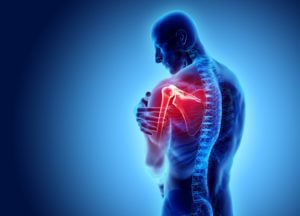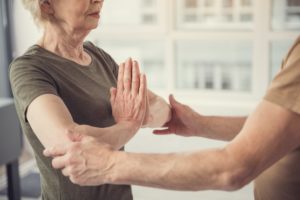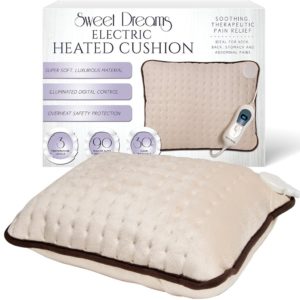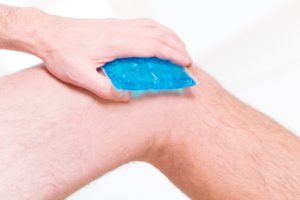
October 12th, 2018 by
Relieve Arthritis Pain With Heat Therapy, Cold Compresses, Exercise, and More
Arthritis is a very common and potentially life-changing condition. Here in the UK, around 10 million people suffer from some form of arthritis and, contrary to popular belief, it doesn’t just affect the elderly. However, there’s no reason to let arthritis slow down your life. If you’ve been diagnosed with arthritis, or if you’re feeling pain in your joints, read on for a bit more information on the condition and how you can treat it with heat and cold.
What Is Arthritis?
 Arthritis is a condition that causes your swelling inside your joints. It leads to discomfort, inflammation, and pain. There are many different types of arthritis, with the most common being osteoarthritis and rheumatoid arthritis (known as RA).
Arthritis is a condition that causes your swelling inside your joints. It leads to discomfort, inflammation, and pain. There are many different types of arthritis, with the most common being osteoarthritis and rheumatoid arthritis (known as RA).
What Causes Arthritis?
Arthritis can be caused by a range of things, usually by injuries or accumulated wear and tear on your joints. It’s much more common in women and people who are over 40, and it can be hereditary. Arthritis can also be brought on by other infections, such as lyme disease. Over time, strenuous activity and injuries can wear away the protective cartilage inside your joints, meaning your tendons aren’t as well-protected and will start to become inflamed. In severe cases, wearing away cartilage can result in bone rubbing against bone inside your joints. This can cause real problems with the shape of your bones, leading to damage and bone spurs among other issues.
Symptoms of Arthritis
As there are many different types of arthritis, there are several potential symptoms. Most common is a frequent tenderness and stiffness around the joints in your hands, wrists, shoulders, spine, hips, knees, or feet. You might notice you can’t move the affected area as freely as you could before, or some swelling. Arthritis sufferers also may experience their joints feeling uncomfortably warm, with the skin over the joint being red and sore.
How to Treat Arthritis
 Unfortunately, there is no cure for arthritis but you can alleviate the pain that it causes by looking after your joints. Regular low-impact exercise will help you stay flexible without putting too much strain on your joints. Consider swimming or yoga instead of going running or using machines at the gym, which can put too much weight on your sore joints and make them feel worse. Regular exercise will also help you stay in shape, as gaining weight can put more pressure on your joints. Arthritis is more common in overweight people as the tendons in their joints have to work much harder to deal with the extra weight. Combining exercise with a healthy diet is therefore one of the best ways to relieve arthritis pain.
Unfortunately, there is no cure for arthritis but you can alleviate the pain that it causes by looking after your joints. Regular low-impact exercise will help you stay flexible without putting too much strain on your joints. Consider swimming or yoga instead of going running or using machines at the gym, which can put too much weight on your sore joints and make them feel worse. Regular exercise will also help you stay in shape, as gaining weight can put more pressure on your joints. Arthritis is more common in overweight people as the tendons in their joints have to work much harder to deal with the extra weight. Combining exercise with a healthy diet is therefore one of the best ways to relieve arthritis pain.
Using Thermotherapy to Treat Arthritis
 Heat pads and electric blankets are two of the best ways to relieve arthritis pain when it flares up and can help you maintain a normal, active life with regular use. Gently applying heat to your sore joints will help increase the blood circulation to the area, keeping you limber and increasing your range of motion. Using a heat pad is one of the easiest and most versatile ways of gently warming your sore joints, and are great if you have arthritic pain in different parts of your body as they’re light and easy to pick up and move around. However, it’s important to make sure you get a quality heat pad that you can hold against your body without the risk of burning yourself. We recommend Sweet Dreams heat pads as they’re made from a thick fabric that provides a cosy, gentle heat that’s perfect for thermotherapy. They’re also incredibly comfortable to hold, so they can be a great mood-booster if arthritis pain has you feeling a little down.
Heat pads and electric blankets are two of the best ways to relieve arthritis pain when it flares up and can help you maintain a normal, active life with regular use. Gently applying heat to your sore joints will help increase the blood circulation to the area, keeping you limber and increasing your range of motion. Using a heat pad is one of the easiest and most versatile ways of gently warming your sore joints, and are great if you have arthritic pain in different parts of your body as they’re light and easy to pick up and move around. However, it’s important to make sure you get a quality heat pad that you can hold against your body without the risk of burning yourself. We recommend Sweet Dreams heat pads as they’re made from a thick fabric that provides a cosy, gentle heat that’s perfect for thermotherapy. They’re also incredibly comfortable to hold, so they can be a great mood-booster if arthritis pain has you feeling a little down.
Using Electric Blankets to Relieve Arthritis Symptoms While You Sleep
It’s also advisable to sleep on an electric blanket in the cold weather, even if you don’t feel particularly cold. While you’re sleeping, you’re lying still for a long time which can cause your muscles and joints to become stiff. This means you’ll feel really sore and rigid when you wake up in the morning even if you felt fine the night before. An electric blanket will help keep the blood circulating around your whole body to reduce muscle tension overnight and leave you feeling relaxed when you wake up. We strongly recommend looking at a Homefront electric blanket, especially a fully fitted one that fits to your bed like a fitted sheet. They’re Which? Best Buy award-winning, so you know you’ll be getting a blanket that you can rely on when you need it most.
Using Cold Compresses to Treat Arthritis
 It’s important to point out that you shouldn’t use heat to treat your arthritis if your joints feel warm already. This means there’s some inflammation in the joint, so adding more heat to the area won’t help. The best treatment for inflammation is to use something cold, although exactly how cold depends on how bad the inflammation is. You might be ok to use a cold flannel, or if the inflammation if quite bad you can use an ice pack or some frozen peas from the freezer. Managing how you use hot and cold therapies to treat different kinds of pain isn’t difficult and will make your life much easier.
It’s important to point out that you shouldn’t use heat to treat your arthritis if your joints feel warm already. This means there’s some inflammation in the joint, so adding more heat to the area won’t help. The best treatment for inflammation is to use something cold, although exactly how cold depends on how bad the inflammation is. You might be ok to use a cold flannel, or if the inflammation if quite bad you can use an ice pack or some frozen peas from the freezer. Managing how you use hot and cold therapies to treat different kinds of pain isn’t difficult and will make your life much easier.
Common Misconceptions About Arthritis
- Arthritis only affects older people. While arthritis is more common in the elderly – and women in particular – it can affect all ages and genders. Around 15,000 children in the UK are affected by arthritis.
- You can cure arthritis. There is no cure for arthritis. Symptoms come and go, but they can be alleviated with proper treatment.
- Cracking your knuckles gives you arthritis. Cracking your knuckles (or any joint) doesn’t cause arthritis. The cracking sound you hear is actually gas bubbles popping, which relieves pressure inside the joint.
- There’s only one kind of arthritis. There are many different kinds of arthritis, and many more related conditions.
- Cutting out all fat from your diet helps prevent arthritis. While a healthy diet is important to alleviate arthritis pain, cutting all fat from your diet could actually make it worse. Healthy fats (not saturated fats) contain antioxidants which can help alleviate the symptoms of rheumatoid arthritis.
Comments
Leave a reply
Your e-mail address will not be published. All fields are required


